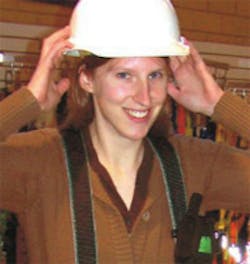We recently posted an article on EHSToday.com about the five most dangerous winter sports: sledding, hockey, ice skating, snowboarding and skiing. One observant reader noticed that this list seems to include all winter sports and wondered if anything else was left. Another reader jumped right in to suggest: “Curling?”
Ah, curling. That bizarre ice sport so revered by our neighbors to the North. Raise your hand if you’ve ever stumbled on a televised curling match during the Winter Olympics and found yourself unable to look away. The graceful, controlled lunging and sliding across the ice. Those funny-looking stones. The frantic sweeping. I admit it: I’m oddly drawn to curling. And while I don’t know much about injury potential within the sport, my brief foray into curling taught me something about commitment.
Curling fascinated me. It didn’t hurt that the sport stresses good sportsmanship and encourages socialization after a match, either. My husband and I would have jumped at the chance to become full members if only for one catch – the club was located all the way on the other side of town. We weren’t confident we could fit the practices and lengthy commute into our schedules. Meanwhile, time was running out for our decision. We couldn’t keep sliding around on packing tape forever, after all. If we were going to become curlers, we had to commit, buy some real curling shoes and get to work.
Workplace safety culture is no different. You can’t slide by on a temporary, quick fix forever. You have to commit.
Troy Bonar, division safety manager at Buffalo Gap Instrumentation & Electrical Co., a 2011 America’s Safest Companies winner, describes three components that can create a commitment to workplace safety: top-of-mind awareness, explaining the “why” and making a connection.
First, top-of-mind-awareness (TOMA), generally considered a marketing technique, also can foster a commitment to safety. Posting safety signs and conducting safety discussions, training or job hazard analyses immediately before beginning work will keep safety fresh and immediate in employees’ minds.
Next, it’s not enough to simply tell workers they should be safe or take certain precautions. You need to explain why they must do so.
“The ‘why’ is important, especially with the younger generation,” Bonar says. “They want to know why people are getting hurt, why they have to wear PPE, why regulations are this way, why this saves lives. Everyone wants to know why.”
Finally, commitment won’t happen in a vacuum. Employees need to feel connected.
“It’s not just training but connecting. You have to connect with each employee,” Bonar explains. “They have to want to learn from you, gain knowledge from you, have some respect for you and be a part of what you’re a part of. When the company can connect with the employees at all levels, then they’re going to see the entire culture change. Employees will be committed to the company and other people. If they’re connected to programs, then the company will see more participation and more buy-in. They’re going to see results.”
Organizations don’t have the luxury of taking a pass on committing to safety, as I eventually (and reluctantly) had to pass on curling. I knew that if I didn’t have the time to consistently attend practices, I would be doing a disservice to my teammates. Similarly, a work force that’s not committed to safety can jeopardize an entire organization. But if you keep safety top-of-mind, explain why it’s necessary and build connections, a committed workplace safety culture will only be a stone’s throw away.
Send an e-mail with your thoughts to [email protected].
About the Author

Laura Walter
Laura Walter was formerly senior editor of EHS Today. She is a subject matter expert in EHS compliance and government issues and has covered a variety of topics relating to occupational safety and health. Her writing has earned awards from the American Society of Business Publication Editors (ASBPE), the Trade Association Business Publications International (TABPI) and APEX Awards for Publication Excellence. Her debut novel, Body of Stars (Dutton) was published in 2021.
